(and Sheldon Place)
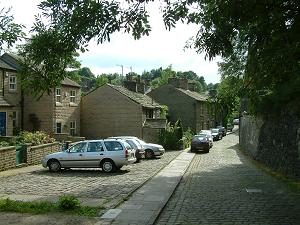 |
One of the prettiest streets in Bollington, the lower part of Queen Street (left) was once part of the main road through this end of town, before much of Palmerston Street was built. Approach off Palmerston Street (at either end of Queen Street or via Pool Bank car park), footway connection (with steps) to Hamson Drive. Leads to Sheldon Place. Nearest shops – Palmerston Street. Nearest pubs – Spinner’s Arms, Holly Bush, The Turners, Cotton Tree, Church House. Restaurants in Palmerston and High streets. Council Ward – Central. |
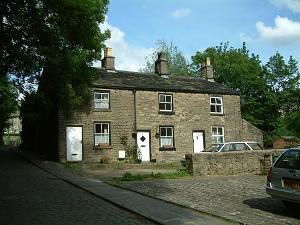 |
In the lower part of the street the stone cottages have survived. In that part there is also a terrace of modern houses (left in top picture) which replaced Ambrose Wood’s metalwork factory. Adjacent to this is Sheldon Place (left), a terrace of three stone cottages at right angles to Queen Street. Named after Stephen Sheldon, b.1777, who is thought to have built them. To the left at this point is Beeston quarry, one of two large (worked out) quarries in this part of the valley, the other being behind Water Street. |
 |
On the corner of Queen Street is Defiance mill which has been restored for domestic use. On the same side all the way up to Palmerston Street there are two terraces of modern cottages (picture below). These replaced the back side of Oak Bank mill which had been built in very ugly concrete in the mid-20th century. Prior to that a Bobbin mill (left, and where the cottages are in the bottom picture) stood next to Defiance Mill (furthest building, left and bottom). The steep part of the street was known as Defiance Brow (more on ‘brows’). It is thought that the junction between Queen Street and Defiance Brow was at the crossing this side of the mills (see picture left). |
 |
Delivering logs to the Bobbin mill on Defiance Brow with a steam engine, c.1930 (left). One of the men was Mr William Pimlott who lived at 67 Palmerston Street and who died in 1943. Their daughter was Enid who lived till 1998. Her son is John Bassett who kindly provided this and other pictures. |
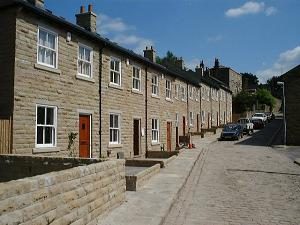 |
Queen Street was refurbished in the 1990s and setts were used to surface the street – just part of the traditional finish. Except that Defiance Brow never did have setts; the historic picture (above) proves the point. This is an example of modern heritage and conservation of the never was. |
Old route
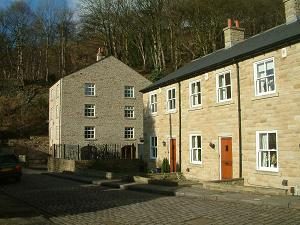
setts in front of them.
Where did Queen Street go from the corner if Defiance Brow was not the main route? Anthony Holland thinks that it may have gone through where Oak Bank mill was later sited. In those days the road to Pott Shrigley was along Ingersley Road. The country part of Shrigley Road, known as Pott levels, was not built until about 1830. There must have been a river crossing (probably a ford) somewhere between Queen Street and Ingersley Road. The bridge at the bottom of Shrigley Road today was possibly built in the 1790s because there is a house just up the hill called Newbridge House, which was built in 1794.
At some point Oak Bank mill would have been located on both sides of the road, the river having been put in a culvert tunnel, but some time later the road would have become a nuisance to the mill and ultimately closed to public passage and integrated with the mill and then built over. Every edition of the OS map from 1896 to 1948 clearly shows a road through the site.
Listed structures
See Listed Buildings page for the full list and notes regarding Listed, Article 4, and SPD properties.
The links on the structures are to the Historic England web site. Any links to local history pages are to this web site.
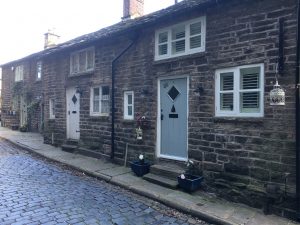 |
16, 18, 20 & 22 Queen Street |
Conservation
This street is in the Bollington Conservation Area. Numbers 2-14, 26-40, 25 and 27 are subject to Article 4 Direction.